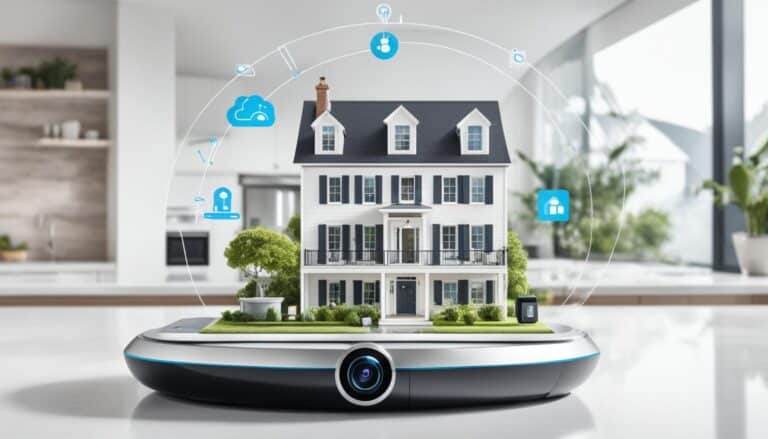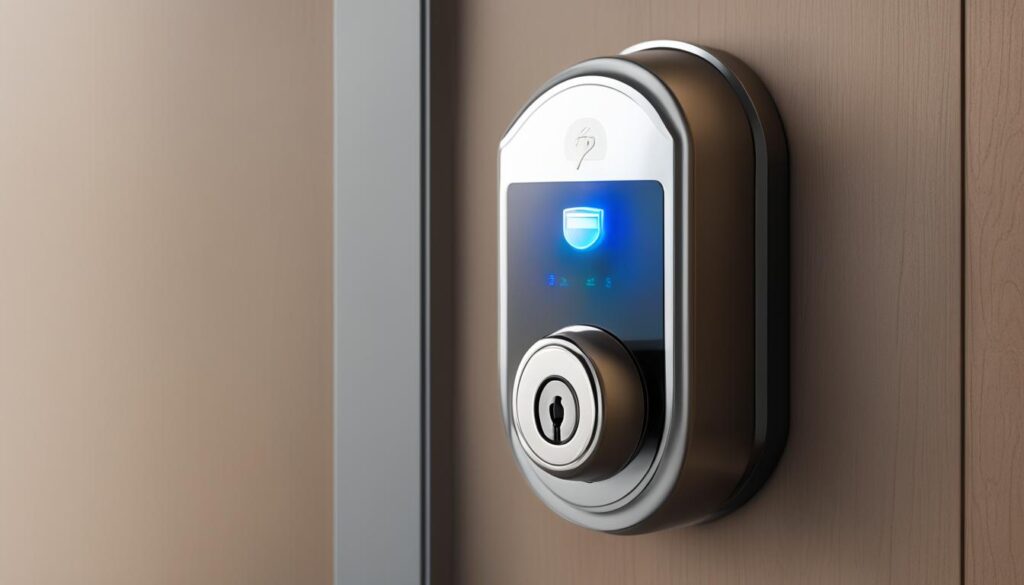The rise of IoT (Internet of Things) technology has revolutionized our homes, providing convenience and automation at our fingertips. However, along with this convenience comes the critical issue of privacy and security in smart homes. With an increasing number of connected devices that collect and transmit data, it is essential to find a delicate balance between IoT convenience and protecting our personal information.
As homeowners embrace the benefits of smart homes, they must be aware of the potential vulnerabilities that come with IoT technology. Connected devices, ranging from smart thermostats and security systems to voice assistants and wearable devices, constantly collect and transmit data to enhance our living experience. This interconnectedness, although valuable, also presents risks in terms of data privacy and security.
Privacy concerns arise when personal data is collected by these devices without the user’s consent or knowledge. Hackers can exploit vulnerabilities in the IoT infrastructure, gaining unauthorized access to sensitive information such as home security system codes or personal identification data. Additionally, data breaches can occur if IoT devices are not properly secured, leading to the exposure of personal information.
However, there are measures that homeowners can take to ensure privacy and security in their smart homes. By implementing strong and unique passwords for each connected device and the home network, homeowners can establish a robust first line of defense. Encryption is also crucial to secure IoT devices, as it encrypts data transmissions and storage, making it challenging for hackers to access sensitive information. Two-factor authentication adds an extra layer of security by requiring users to provide a second form of verification before accessing IoT devices.
As IoT technology continues to evolve, the future of privacy in smart homes looks promising. Manufacturers are increasingly prioritizing privacy features, such as enhanced encryption and privacy settings, to protect users’ personal information. Advancements in machine learning and artificial intelligence may also lead to more intelligent and proactive privacy solutions for smart homes.
Protecting privacy in the age of IoT in smart homes is a complex task, but it is not impossible. By understanding the potential risks, implementing security measures, and staying informed about emerging privacy issues, homeowners can take control of their privacy and ensure the security of their smart homes. Balancing the convenience of IoT technology with privacy and security is essential for creating a safe and comfortable living environment in the increasingly interconnected world of smart homes.
Key Takeaways:
- IoT technology brings convenience and automation to smart homes, but it also raises concerns about privacy and security.
- Connected devices in smart homes collect and transmit personal data, creating potential vulnerabilities for hackers to exploit.
- Privacy concerns include unauthorized access to sensitive information and data breaches if devices are not properly secured.
- Homeowners can protect their privacy by using strong passwords, implementing encryption, and enabling two-factor authentication.
- Manufacturers are incorporating privacy features into IoT devices, and advancements in technology may lead to more intelligent privacy solutions in the future.
The Growth of IoT in Smart Homes
The rise of IoT (Internet of Things) technology has revolutionized the way we live, particularly in the realm of smart homes. With an ever-increasing number of connected devices, smart homes have become hubs of convenience, efficiency, and automation. From smart thermostats and home security systems to voice assistants and wearable devices, IoT has infiltrated all aspects of our daily lives, making our homes smarter and more intuitive.
Connected devices in smart homes collect and transmit data, enabling various functionalities and seamless integration. For example, a smart thermostat can learn our preferences and adjust the temperature accordingly, while a smart security system allows us to monitor our home remotely. These devices form a network of interconnected technology, collectively known as the Internet of Things, enabling us to control and manage our homes with ease.
However, as much as IoT brings convenience, it also raises concerns about data privacy and security. The very nature of connected devices leads to the collection and storage of personal data, ranging from our daily routines and habits to sensitive information such as passwords and financial details. This data collection presents potential vulnerabilities, making smart homes susceptible to unauthorized access and data breaches.
Homeowners must be aware of the risks associated with IoT in smart homes and take proactive measures to safeguard their privacy and data. This includes implementing strong security protocols, such as encryption and authentication, to protect sensitive information from potential threats. Regularly updating device firmware and using trusted brands and manufacturers for IoT devices can also help ensure a secure smart home environment.
In conclusion, the growth of IoT technology has brought about significant advancements in smart homes, transforming our living spaces into intelligent and interconnected environments. While the convenience and automation provided by IoT are invaluable, it is crucial for homeowners to prioritize data privacy and security. By understanding the potential risks and taking appropriate measures, we can fully enjoy the benefits of smart homes while safeguarding our privacy and personal data.
| Benefits of IoT in Smart Homes | Concerns with IoT in Smart Homes |
|---|---|
|
|
Privacy Concerns in Smart Homes
In the world of smart homes, privacy concerns arise due to the collection and utilization of personal data by connected devices. The interconnected nature of these devices poses potential risks, with hackers exploiting vulnerabilities in the IoT infrastructure to gain unauthorized access to sensitive information. This includes home security system codes and personal identification data, leaving homeowners vulnerable to privacy breaches.
Data breaches also contribute to privacy concerns in smart homes. If IoT devices are not adequately secured, personal information stored within them becomes exposed. This can lead to severe repercussions, as unauthorized individuals may gain access to personal data and misuse it.
As smart homes become more prevalent, it is crucial for homeowners to be aware of these privacy risks and take appropriate measures to mitigate them. Encrypting data is a significant step towards safeguarding personal information. By using encryption methods, data transmissions and storage can be protected from unauthorized access.
Furthermore, using strong passwords is essential in maintaining privacy. Homeowners should create unique and complex passwords for each connected device and their home network to prevent unauthorized access.
Regularly updating device firmware is another crucial aspect of ensuring privacy in smart homes. Manufacturers release firmware updates to address security vulnerabilities, and by staying up-to-date with these updates, homeowners can protect their devices from potential breaches.
Overall, homeowners need to prioritize privacy in smart homes by implementing security measures such as encryption, strong passwords, and regular firmware updates. By doing so, they can mitigate privacy concerns and create a secure environment for their personal information.
Takeaways:
- Hackers exploit vulnerabilities in the IoT infrastructure to gain unauthorized access to sensitive information in smart homes.
- Data breaches may occur if IoT devices are not properly secured, leading to the exposure of personal information.
- Encrypting data, using strong passwords, and regularly updating device firmware are crucial steps to mitigate privacy concerns in smart homes.
Ensuring Privacy and Security in Smart Homes
When it comes to smart homes, ensuring privacy and security is essential to protect against potential risks. Homeowners can implement various measures to safeguard their IoT devices and maintain a safe living environment. Here are some key steps to consider:
- Use strong and unique passwords: Creating strong and unique passwords for each connected device and the home network is a fundamental step in enhancing security. Avoid using easily guessable passwords and consider using password managers to simplify this process.
- Encrypt data transmissions and storage: Encryption serves as a crucial protective measure for IoT devices. By encrypting data during transmission and when storing it, homeowners can ensure that sensitive information remains secure and safeguarded from unauthorized access.
- Implement two-factor authentication: Adding an extra layer of security through two-factor authentication can significantly enhance smart home security. By requiring users to provide a second form of verification before accessing IoT devices, the risk of unauthorized access is minimized.
- Regularly update device firmware: Keeping IoT devices up to date with the latest firmware releases is vital. Manufacturers often release firmware updates to address security vulnerabilities and improve device performance. Staying proactive in updating firmware helps protect against potential exploits.
- Choose reputable manufacturers: Opting for IoT devices from reputable manufacturers can significantly contribute to overall privacy and security. Established brands often prioritize security measures in their products, ensuring a higher level of protection for homeowners.
By following these steps and adopting a proactive approach to privacy and security, homeowners can create a safe and secure smart home environment. Investing time and effort into securing IoT devices is well worth it in order to enjoy the convenience and automation of smart homes without compromising privacy and security.
Protecting Privacy and Security: A Table Comparison
| Security Measures | Benefits |
|---|---|
| Strong and unique passwords | Prevents unauthorized access to connected devices and home network. |
| Encryption of data transmissions and storage | Safeguards sensitive information against interception and unauthorized access. |
| Two-factor authentication | Adds an extra layer of security by requiring additional verification. |
| Regular firmware updates | Addresses security vulnerabilities and improves device performance. |
| Choosing reputable manufacturers | Ensures devices are designed with privacy and security in mind. |
The Future of IoT and Privacy in Smart Homes
As IoT technology continues to advance, the future of privacy in smart homes holds great promise and intriguing possibilities. Manufacturers are increasingly focused on incorporating robust privacy features into their devices, leveraging advancements in encryption and privacy settings. These advancements aim to provide users with enhanced control over their personal information and data security.
One exciting development in the future of smart homes is the potential for greater integration of machine learning and artificial intelligence (AI). These technologies may enable more intelligent and proactive privacy solutions for smart homes, taking privacy protection to new heights. For example, AI algorithms can continuously analyze data flows in real-time to detect any potential privacy breaches and automatically activate necessary safeguards to mitigate risks.
Despite the promising future, it is important to acknowledge that as IoT technology progresses, potential privacy risks evolve as well. It is crucial for smart homeowners to stay informed about emerging privacy issues and actively implement security measures to protect their personal information and maintain control over their smart homes.
Ensuring Privacy and Security in the Future of Smart Homes
In order to navigate the evolving landscape of IoT in smart homes, homeowners should consider the following measures:
- Regularly update IoT devices’ firmware to ensure that security patches are applied promptly.
- Use strong and unique passwords for each connected device and the home network.
- Implement robust encryption protocols to secure data transmissions, both within the home network and between devices.
- Utilize reputable manufacturers and vendors to ensure the reliability and security of IoT devices.
- Stay informed about privacy best practices and emerging technologies to proactively address potential risks.
Embracing the future of IoT in smart homes requires a proactive approach towards privacy and security. By staying vigilant and taking appropriate measures, homeowners can enjoy the convenience and automation that smart homes bring while safeguarding their personal information.
As we move forward into the future, it is crucial to strike a balance between the benefits of IoT technology and the protection of our privacy. Only by embracing advancements in privacy features and implementing robust security measures can we ensure that our smart homes remain safe and private sanctuaries in the digital age.
Conclusion
Protecting privacy in the age of IoT in smart homes is a complex task, but it is not impossible. As the number of connected devices in our homes continues to grow, so does the need to prioritize privacy and security. By understanding the potential risks associated with IoT technology and taking proactive measures, homeowners can regain control of their privacy and ensure the security of their smart homes.
Implementing security measures is crucial in safeguarding personal information and data. From using strong and unique passwords for each connected device to regularly updating device firmware, these steps can significantly reduce the vulnerabilities of IoT devices. Encrypting data transmissions and storage adds an additional layer of protection, preventing unauthorized access and potential data breaches.
Staying informed about emerging privacy issues is equally important. As technology advances, manufacturers are continuously developing new features and enhancements to address privacy concerns. Keeping up-to-date with the latest advancements and incorporating them into smart home setups can further enhance privacy and security. Additionally, maintaining a proactive approach to privacy, such as monitoring privacy settings and opting for reputable manufacturers, allows homeowners to continue adapting to evolving privacy landscapes.
In the increasingly interconnected world of smart homes, balancing the convenience of IoT technology with privacy and security is vital. By embracing a proactive mindset and implementing the necessary measures, homeowners can create a safe and comfortable living environment. With an understanding of the potential risks, armed with security measures, and equipped with knowledge about emerging privacy issues, homeowners can confidently navigate the IoT landscape and protect their privacy in smart homes.
FAQ
How does IoT technology impact privacy in smart homes?
IoT technology in smart homes collects and transmits data, raising concerns about privacy and security. Connected devices may store personal information and create vulnerabilities for hackers.
What are the privacy concerns in smart homes?
Privacy concerns in smart homes include the unauthorized access and potential data breaches of personal information by hackers. This can lead to the exposure of sensitive data and the compromise of home security systems.
How can homeowners protect their privacy and security in smart homes?
Homeowners can protect their privacy and security in smart homes by using strong and unique passwords for each connected device and home network. Encrypting data, implementing two-factor authentication, and regularly updating device firmware are also important security measures.
What is the future of privacy in smart homes?
The future of privacy in smart homes will likely see advancements in privacy features, such as enhanced encryption and privacy settings. Manufacturers are also focusing on incorporating machine learning and artificial intelligence solutions for proactive privacy protection.
How can homeowners balance IoT convenience with privacy and security?
Homeowners can balance IoT convenience with privacy and security by staying informed about emerging privacy issues, implementing security measures, and being proactive in protecting their personal information. This includes regularly updating devices and staying informed about reputable manufacturers.
Source Links
- https://robots.net/computing-and-gadgets/wearables/which-sennheiser-gaming-headset-to-buy/
- https://robots.net/gaming-and-entertainment/pc-gaming/how-to-set-up-a-game-controller-for-fortnite/
- https://robots.net/computing-and-gadgets/wearables/how-to-set-up-logitech-981-000541-g230-stereo-gaming-headset-with-mic/



